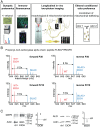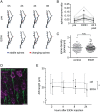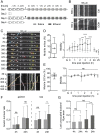Single-dose ethanol intoxication causes acute and lasting neuronal changes in the brain
- PMID: 35700362
- PMCID: PMC9231489
- DOI: 10.1073/pnas.2122477119
Single-dose ethanol intoxication causes acute and lasting neuronal changes in the brain
Abstract
Alcohol intoxication at early ages is a risk factor for the development of addictive behavior. To uncover neuronal molecular correlates of acute ethanol intoxication, we used stable-isotope-labeled mice combined with quantitative mass spectrometry to screen more than 2,000 hippocampal proteins, of which 72 changed synaptic abundance up to twofold after ethanol exposure. Among those were mitochondrial proteins and proteins important for neuronal morphology, including MAP6 and ankyrin-G. Based on these candidate proteins, we found acute and lasting molecular, cellular, and behavioral changes following a single intoxication in alcohol-naïve mice. Immunofluorescence analysis revealed a shortening of axon initial segments. Longitudinal two-photon in vivo imaging showed increased synaptic dynamics and mitochondrial trafficking in axons. Knockdown of mitochondrial trafficking in dopaminergic neurons abolished conditioned alcohol preference in Drosophila flies. This study introduces mitochondrial trafficking as a process implicated in reward learning and highlights the potential of high-resolution proteomics to identify cellular mechanisms relevant for addictive behavior.
Keywords: Drosophila; addiction; ethanol; plasticity; two-photon microscopy.
Conflict of interest statement
The authors declare no competing interest.
Figures





Comment in
-
Alcohol, neuronal plasticity, and mitochondrial trafficking.Proc Natl Acad Sci U S A. 2022 Jul 19;119(29):e2208744119. doi: 10.1073/pnas.2208744119. Epub 2022 Jul 11. Proc Natl Acad Sci U S A. 2022. PMID: 35858366 Free PMC article. No abstract available.
References
-
- DeWit D. J., Adlaf E. M., Offord D. R., Ogborne A. C., Age at first alcohol use: A risk factor for the development of alcohol disorders. Am. J. Psychiatry 157, 745–750 (2000). - PubMed
-
- Hingson R., Heeren T., Zakocs R., Winter M., Wechsler H., Age of first intoxication, heavy drinking, driving after drinking and risk of unintentional injury among U.S. college students. J. Stud. Alcohol 64, 23–31 (2003). - PubMed
Publication types
MeSH terms
Substances
LinkOut - more resources
Full Text Sources
Molecular Biology Databases

